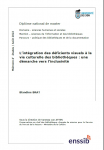L’intégration des déficients visuels à la vie culturelle des bibliothèques : une démarche vers l’inclusivité
- Auteur : Brat, Blandine
- Directeurs de mémoire ou de thèse : van Atten, Vanessa, van Atten, Vanessa
- Description : Mémoire d'études de M2 Politique des bibliothèques et de la documentation à propos de la question de l'inclusivité et traitant en particulier de l’intégration des déficients visuels à la vie culturelle des bibliothèques.
- Résumé en français : L’ouverture des bibliothèques aux publics en situation de handicap est un phénomène dont l’ampleur s’intensifie ces dernières décennies, en lien avec l’évolution des mentalités et le désir d’une société plus inclusive. La déficience visuelle a longtemps été au centre des considérations des bibliothèques, surtout l’accessibilité aux bâtiments et aux collections. Cependant, l’accessibilité aux animations est encore un domaine négligé en dépit de l’importance sociale et culturelle qu’il représente pour ces usagers. En s’appuyant sur les propos d’une pluralité de professionnels des bibliothèques, ce travail a pour objectif de dresser un état de lieux de l’accessibilité à la vie culturelle des bibliothèques pour les usagers en situation de handicap visuel. En soulevant les forces et les faiblesses des bibliothèques face à cette problématique, des initiatives seront proposées, en termes de création d’un environnement adapté, de communication et d’adaptations de la programmation culturelle afin d’ouvrir les animations des bibliothèques au public déficient visuel. Cette inclusion aux bibliothèques a toute son importance puisqu’elle est le miroir des mutations sociétales à propos de l’acceptation des différences et de l’importance de la singularité de l’individu face à la société.
- Résumé en anglais : The openness of libraries to people with disabilities is a phenomenon whose scope has intensified in recent decades, in connection with the evolution of mentalities and the desire for a more inclusive society. Visual impairment has long been a central consideration for libraries, especially accessibility to buildings and collections. However, accessibility to entertainment is still a neglected area despite the social and cultural importance it represents for these users. Based on the comments of a plurality of library professionals, this work aims to draw up an overview of the accessibility of libraries to cultural life for users with visual disabilities. By raising the strengths and weaknesses of libraries facing this issue, initiatives will be proposed, in terms of creating a suitable environment, communicating and adapting cultural programming in order to open library animations to the visually impaired public. This inclusion in libraries is very important because it mirrors societal changes about the acceptance of differences and the importance of the singularity of the individual vis-à-vis society.
- Collection : Mémoires Master "Politique des bibliothèques et de la documentation"
- Thèmes : Services et publics , Services au public , Action culturelle
- Licence de diffusion : Licence Creative Commons

- Format : Fichier Adobe PDF
- Date de création : 22 août 2022
- Étendue : 1,97 Mo
- Étendue : 107 p.
- Date de publication : 22 août 2022
- Langue : fr
- Éditeur ou organisme : Enssib
- Sujet(s) : Handicap Déficience visuelle Actions culturelles Bibliothèques publique
- Type de ressource : text
- Type de mémoire : Mémoire d’étude
- Diplôme : Master 2 PBD Politique des bibliothèques et de la documentation

